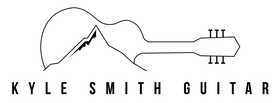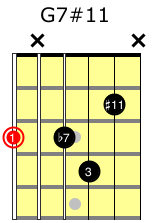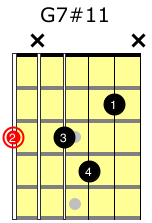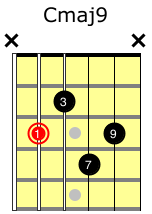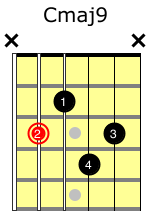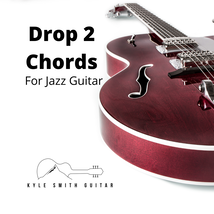 Drop 2 chords are an important part of any jazz guitar players chord vocabulary, and introduce new sounds into your guitar playing. These chords give you a tighter finger pattern than drop 3 chords do, and have sometimes been called block chords, and other names over time - but Drop 2 is the name we use today. Drop 2 chords are particularly helpful on guitar because they let you put the top note of your chord on the 1st string, or the second string. This opens up more range for your chord playing, helps you accompany soloists better, and makes it easier to harmonize melodies for solo guitar playing. Learning your drop 2 chords will also introduce new stretchy chord shapes, and expand your chord vocabulary.
0 Comments
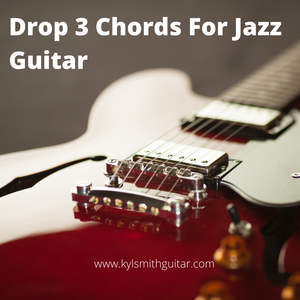 If you're learning to play jazz guitar, drop 3 chords are an important chord shape for you to become familiar with. These chord shapes can help you build a foundation of jazz guitar chord knowledge that will serve you well for years. Drop 3 chords are relatively finger friendly, and they sound good in a variety of situations:
As you become more advanced, these chords can also help you develop the ability to walk bass lines up and down the neck as you play the chords to a song. Lots of people become familiar with one or two of these Drop 3 chord shapes as they begin learning jazz guitar, but never learn the whole system. This leads many aspiring jazz guitarists to become stuck with root position chords, and limited in their chord vocabulary. Learning the whole system (only 4 shapes) will help you to:
These things start to happen automatically as you become accustomed to playing with your Drop 3 chords.  When it comes down to it, I really love playing jazz guitar. Playing jazz guitar is fun, challenging, and rewarding all at the same time. Playing jazz gives you a way to express yourself musically, explore your creativity, and enhance your knowledge of music theory and the guitar fretboard. I've been hooked on jazz guitar ever since I found out there was a band at school that I could play guitar in. I joined the jazz band and have been playing jazz ever since. While at first learning jazz guitar was just a way to get to play guitar at school, it soon became a lifelong study of this amazing style of music. When you're new to jazz, it can seem like there is a ton of learning that you need to do before you even start to play jazz guitar. (Let alone playing entire songs!) This isn't necessarily true - Learning how to play jazz guitar requires the same basic guitar playing skills as any other style of music. If you take it one step at a time, you can absolutely learn how to play jazz guitar - you just have to learn to apply your guitar playing skills to this great style of music.  At some point in your jazz guitar playing career, someone is going to ask you to use something called "rootless voicings" for your chords. This is especially true if you're playing in a jazz ensemble or small group at the high school or college level. (If you're playing professionally, you probably already know what rootless voicings are, how to use them, and when to use them in your playing.) The theory here is that if you're playing the root as a part of your chord, it's an unnecessary note because the bass player is playing the root as a part of their bass line. While I don't 100% agree with this idea as a fundamental rule, it's still important for you to learn how to play these rootless chords. You want to be able to do what your director/bandleader/etc asks you to do - it's your job as the guitar player, and they are likely hearing things out front that you are not hearing from your seat by the amplifier. By dropping off the root from your basic jazz guitar chords you open up new possibilities for color, and free up your hands for simpler "grips" on your chords. Even when you're not asked to, experiment with using these chords to see what they sound like in a playing situation. Eventually, you want to be able to decide whether or not to include the root at the bottom of your chord based on the situation (song, style, band, soloist preferences).  Adding an extra note on the 2nd string is a good way to add some color to your fundamental jazz guitar chords. For our purposes, we are going to call these notes color tones While the fundamental chords give you a really clean representation of the jazz chord, adding color tones gives you more control over the sound, more ability to play specific chords that pop up in your music, and make playing chords a lot more fun. This is a helpful jazz guitar voicing for a G7#11 chord. This is a movable voicing with the root on the 6th string, meaning that you can change the letter name of this chord by moving it up or down the neck. Note: The #11 can also be called a b5. You might see G7#11 or G7b5 on a chord chart, but this chord shape covers either name. On the left is the G7#11 chord shown with the chord tones/intervals used, and on the right is the recommended finger pattern. This chord can be used for any dominant 7th (G7, C7, etc) type chord you come across.
Whether it calls for G7, G9, or anything else with a 7 or higher in the chord symbol, this chord will work. This is a helpful jazz guitar voicing for a Major 9th chord. This is a movable voicing with the root on the 5th string, meaning that you can change the letter name of this chord by moving it up or down the neck. On the left is the Cmaj9 chord shown with the chord tones/intervals used, and on the right is the recommended finger pattern. This chord can be used for any major 7th type chord you come across. Whether it calls for Cmaj7, Cmaj9, or anything else with a “maj” in the chord symbol, this chord will work.
 Once you’re comfortable with the basic 3 note jazz guitar chord shapes, it’s time to start applying them to chord progressions. Chord progressions are sequences of chords that fit together in a key song. If you don't know the basic 3 note jazz guitar shapes yet, click here. From a practical standpoint, playing a chord progression means smoothly moving from one chord to another. While you could jump straight into learning songs, there is a simple chord progression that you should probably learn first. The 2 5 1 (or ii V I) progression is an extremely common progression to come across in jazz music, and it is a great place for you to start when you are comfortable with your basic jazz guitar chords. Because it is so common, this progression should be internalized and it’s a good idea to practice it in every key. In this lesson you will learn 2 different patterns for the 2 5 1 progression that you can use at any point of the guitar to play in different keys. One of these patterns starts and ends on the 6th string, so we’ll call it the 6th string pattern. The other pattern starts and ends on the 5th string, so we’ll call it the 5th string pattern.  When I started learning jazz guitar, I pretty much only worked on learning chords. I had a great teacher who had a pretty “old school” approach. Lots of exercises with different chords, finding them all over the neck so you always had an option for your next chord. I got really good at sight reading chords - and the kind of charts you would get in a jazz band. Traditional Comping ApproachHe was also very traditional in his approach to accompaniment, which is the guitar players main job in a jazz band - “4 to a bar” playing where you strum once on each beat. This worked great for me for a long time. I mostly played guitar in jazz band, so that style worked perfectly in most of the situations I encountered. I started getting hired for groups around town, playing for weddings, events, and pit orchestras for musical productions as a high school kid. Eventually I Needed Something DifferentOnce I got to college though, I started encountering situations where this 4 to a bar style accompaniment wasn’t working as well. And as I listened to a wider variety of jazz music, I noticed that the guitar was sometimes doing all kinds of different rhythm patterns behind melodies and soloists. I Learned A Lot About Different Comping StylesOver time, I worked with several different jazz guitar teachers. I would book a lesson with anyone I could as they came through town, or sometimes I would travel across the state to meet with a great teacher for an hour. Through these teachers and my university professors, I was able to identify some general rules about accompaniment that helped me improve my playing, and help me sound better in a wider range of jazz styles. Now I was getting hired by jazz groups in my new local area, which was much more competitive than where I grew up. I even won a couple of guitar jobs over older, more experienced guitar players - partially because of my comping ability. Over Time, I Figured Out What Really WorksAs a guitar teacher, I’ve worked with students of a wide range of ability levels - from kids starting out in jazz band to serious high school and college age students to adults who want to learn jazz guitar for fun. Over the years I’ve found 3 basic comping rhythms that work well as an entry point for most players. By mastering these three patterns and learning how to switch between them, you’ll have a good foundation for becoming the kind of jazz guitar player that people want to play with and listen to. Note - A lot goes in to good accompaniment skills, and just learning one or two patterns isn’t necessarily going to cut it. But that doesn’t mean you have to learn thousands of rhythm patterns either. What You'll LearnIn this lesson you’ll learn 3 important comping rhythms - Freddie Green, The Charleston, and the Reverse Charleston.
More importantly, you’ll learn how to piece these rhythms together in a way that will sound good and support a melody or soloist. Comping is an essential jazz guitar skill, and it’s one of the most important parts of playing jazz guitar with other people. It is also a very overlooked area of many guitarists playing. If you take the time to develop your comping skills, it can set you apart as a jazz guitarist, and help you get more opportunities to play with better groups.  Once you’ve learned the chords on the 6th string, your next goal will be to learn the chords on the 5th string. While the jazz guitar chords on the 6th string are a great starting point, you’ve probably noticed by now that you have to jump all over the place to play a song. In this lesson, you start to add in the jazz guitar chords on the 5th string, and you’ll start to be able to find your next chord without having to move more than a couple of frets most of the time. Once you add these chords into your vocabulary, playing through jazz songs will be a much easier process. In this lesson you’re going to learn the basic 3 note jazz guitar chord shape starting on the 5th string. You’ll also learn how to change this shape to create any chord you need using basic music theory rules. |
